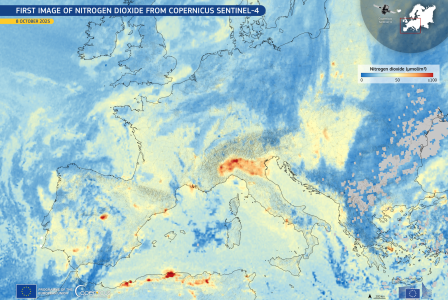News & articles
22 October 2025
First image of nitrogen dioxide from Copernicus Sentinel-4
News & articles
22 October 2025
Cross-cutting policy
Login / create an account to be able to react
-
1 view

The new Copernicus Sentinel-4 mission has delivered its first images, highlighting concentrations of atmospheric nitrogen dioxide, sulphur dioxide and ozone.
Editorial team
European Commission
Topics
EU-27
EU Institutions
-
Policy type
-
-
Cross-cutting policy
-
Share
This image, based on the Sentinel-4 very first measurements acquired on 8 October 2025, depicts tropospheric nitrogen dioxide with clear pollution hotspots visible along the Mediterranean coast and over Italy’s Po Valley.
As a major air pollutant released during the combustion of fossil fuels, such as in vehicle engines, power plants and heating systems, concentrations of nitrogen dioxide can change rapidly. It is toxic on its own and also contributes to the formation of secondary pollutants like ozone and particulate matter both of which have serious impacts on human health and the environment.
Despite being preliminary, these images mark a major milestone in Europe’s ability to monitor air quality all the way from geostationary orbit, 36,000 kilometres above Earth.
The Copernicus Sentinel-4 mission was successfully launched on July 1, 2025, from Cape Canaveral and is now in orbit. It marks the first geostationary Copernicus mission dedicated to monitoring air quality above Europe specifically, enhancing the EU’s Earth Observation capabilities.
Sentinel-4 carries a state-of-the-art UVN (Ultraviolet Visible Near-infrared) spectrometer designed to precisely measure key atmospheric pollutants such as ozone (O₃), nitrogen dioxide (NO₂), formaldehyde (HCHO), sulphur dioxide (SO₂), and aerosols.
Once fully calibrated, the satellite will deliver hourly data on atmospheric composition. This information will support the Copernicus Atmosphere Monitoring Service (CAMS) in providing real-time insights to scientists, policymakers, and environmental agencies, aiding efforts to reduce pollution and improve air quality across Europe.
The mission contributes directly to EU environmental policies, including the Ambient Air Quality Directive and the Zero Pollution Action Plan.
Comments (0)
See also
Moving forward together: A Bolder, Simpler, Faster Union
- Categories
- Digital transition EU Policy Green transition
Commissioner Jørgensen in Greece to celebrate 20 years of the Energy Community and discuss energy and housing policies
- Categories
Restoring LIFE to Europe’s polluted water supplies
- Categories



